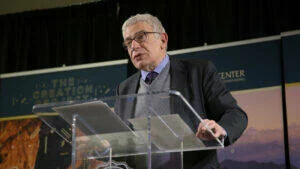I am grateful for Jonathan Pennington’s wise and insightful study. I learned a great deal from it, and was delighted by its delivery on the promise in its subtitle: to offer a theological engagement with the biblical text.
Indeed, Pennington extends the conversation more widely still, drawing Matthew into intelligent and fruitful conversation with both philosophical and pastoral concerns. What emerges is a winsome model of both biblical theology and theologically informed biblical scholarship. What I have learned from Pennington’s text will help develop my own writing and research in systematic theology, but I also want to extend and develop his work on human flourishing, specifically in the area of pneumatology.
Pennington does not make an explicit connection between flourishing and the Holy Spirit, but many theologians have. In a beautifully poetic passage, redolent with the language of flourishing, Moltmann describes the Spirit as “the Spirit of the resurrection of the dead and of eternal livingness.” And so, he writes:
If we are seized by the Spirit of the resurrection, we get up out of our sadness and apathy. We begin to flower and become fruitful again, like the plants and trees in the spring of the year. An undreamed-of love for life awakens in us; we drive out the sweet poison of resignation, and our painful remembrances of death are healed. We encounter life again, like children, in eager expectancy.Jurgen Moltmann, The Source of Life: The Holy Spirit and the Theology of Life (Minneapolis: Fortress, 1997), 80-81.
Centuries earlier, Calvin would likewise describe the Spirit’s work by appealing to vivid imagery of blossoming and growth. He writes:
It is the Spirit who, everywhere diffused, sustains all things, causes them to grow, and quickens them in heaven and in earth . . . He is circumscribed by no limits . . . but [transfuses] into all things his energy . . . breathing into them essence, life, and movement.John Calvin, The Institutes of the Christian Religion, I. xiii. 14.
These theologians are not being unduly creative. Rather, they are drawing out the same connection between Spirit and flourishing recognized in the Nicene Creed, which identifies the Spirit as “the Lord, the giver of life.” And, of course, the Fathers at Nicaea and Constantinople in turn were at this point merely unfolding the testimony of both Old and New Testament, where the ruach and pneuma is the breath of God, which gives life and vitality to all of creation. And Pennington’s own reading of the Sermon suggests obvious connections with the Spirit’s work—I’ll mention a few.
The Sermon and the Spirit
First, Pennington commends an “aretegenic” reading of the Sermon. By “aretegenic” Pennington means “for the purpose of forming character or virtue” (xxxv). There are obvious resonances here with the Spirit as the one who forms Christian character, or more properly, who forms the character of Christ within us. Pennington likewise identifies the elements of the Sermon which are characteristic of apocalyptic literature, and which point to the hope of the “coming age.” Again, the connections with the work of the Spirit are patent. The giving of the Spirit, as Peter’s speech in Acts 2 makes plain, is part of the eschatological hope announced by the prophets and is one of the marks of “the Last Days.”
Closely related to this is Pennington’s observation that that the macarisms of Matthew 5 are both sapiential and eschatological proclamations. The “blessedness” or flourishing Jesus describes includes an element of present flourishing, but also points ahead to an eschatological reality. Here again, the Sermon describes something that Christian theology generally associates with the work of the Spirit. As Yves Congar says, “our inheritance is eschatological. The Holy Spirit is given to us in the present time as a ‘guarantee of our inheritance until we acquire possession of it’ (Eph. 1:14; cf. 4:30).”Yves Congar, I Believe in the Holy Spirit (New York: Crossroad, 1997), 31.
Finally, the second of the “conceptual rails” along which Pennington’s argument runs is that of teleios (wholeness/perfection). This motif likewise points us to the work of the Spirit. Basil the Great writes that through the Spirit “hearts are lifted up, the infirm are held by the hand and those who progress are brought to perfection.”Basil the Great, On the Holy Spirit (Yonkers: St. Vladimir’s Seminary Press, 1980), 44. Similarly, Colin Gunton describes the Spirit as the “perfecting cause . . . the eschatological member of the Trinity . . . who brings about in advance the perfection of particular created actions and things.”Colin Gunton, The Christian Faith: An Introduction to Christian Doctrine (Hoboken: Wiley-Blackwell, 2001), 155.
Searching for the Spirit in Matthew
One might acknowledge all of this, and then say (perhaps with a sigh): “Well yes, but all of this is very Pauline! This is a much more fully developed pneumatology than anything we find in Matthew.” Along these lines, Pennington quotes Charles Talbert in a footnote, observing Matthew’s “underdeveloped” pneumatology. One might go on to say that “while a pneumatological understanding of human flourishing is appropriate to Paul, it is absent from Matthew’s Sermon on the Mount.”
This sort of concession might not be a bad thing. Yet, even if this were the case—if Matthew lacks the kind of gestures toward the Spirit that we find elsewhere in the New Testament—we might be glad to discover that Matthew’s Sermon and the pneumatology of the rest of the New Testament fit together like two matching pieces of a puzzle. Such a close fit would point to the way in which the Spirit carries out and completes in us the life of Jesus. The Spirit empowers us to live the life Matthew’s gospel call us to. And so,I wonder if we can say more about the fit between the Sermon’s vision of human flourishing and the work of the Holy Spirit. I would not be distressed if I had to concede that Matthew is pneumatologically impoverished. I wonder if we can say more about the fit between the Sermon’s vision of human flourishing and the work of the Holy Spirit. In particular, I wonder whether it is possible to discern greater emphasis on the Spirit in Matthew than much recent Matthean scholarship has allowed.
First of all, we might consider how the Holy Spirit frames Matthew’s gospel: with five mentions of the Spirit in the first four chapters and a further mention of the Spirit in the penultimate verse of the final chapter. After the opening genealogy, the same verse that initiates the narrative of Jesus’ life also declares that Mary was found to be pregnant “through the Holy Spirit (ek pneumatos hagiou)” (Matt. 1:18). This announcement is underlined when the angel informs Joseph: “what is conceived in her is from the Holy Spirit (ek pneumatos estin hagiou)” (Matt. 1:20). Among the first things we are told about Jesus is that he is sent through the agency of the Holy Spirit and that he is from the Holy Spirit.
The third chapter introduces the public ministry of Jesus with two further mentions of the Spirit. The one who is coming, John declares “will baptize you with the Holy Spirit and fire” (Matt. 3:11). Following his baptism, Jesus is visibly anointed and empowered by the Spirit, “he saw the Spirit of God descending and alighting on him as a dove” (Matt. 3:16). The next verse tells us that Jesus was then “led by the Spirit into the wilderness” (Matt. 4:1). TakingThis “Spirit framing” is more than a formal device, rather, it ties Jesus’ mission and the mission of the church together, locating both of these within the larger missio Dei. Jesus’ followers are now sent forth for mission by the same Spirit that sends forth Jesus. all this together we can say that in introducing Jesus, Matthew emphasizes that he is from, sent by, empowered and directed by the Spirit. All of this serves as a prelude to the Sermon.
The Gospel of Matthew concludes with another mention of the Spirit, “baptizing them in the name of the Father and the Son and the Holy Spirit” (Matt. 28:19). Here it is not Jesus, but his followers who are being sent, empowered and directed, but by the same Spirit who sent and empowered Jesus. Jesus’ followers will now be baptized and baptize others in the name of the Spirit who empowered Jesus at his baptism. This “Spirit framing” is more than a formal device, rather, it ties Jesus’ mission and the mission of the church together, locating both of these within the larger missio Dei. Jesus’ followers are now sent forth for mission by the same Spirit that sends forth Jesus.
In addition to this, Matthew presents Jesus as a second Moses, and, indeed, one greater than Moses, who ascends a mountain and brings divine teaching to the people. It is notable that this ascent to the mountain in Matthew 5 is preceded by two Spirit-initiated moments: Jesus, anointed by the Spirit, going through the waters of the Jordan as Moses hoped to but could not (Matt. 3); and Jesus, like Moses and the children of Israel, being led out into the desert by the Spirit (Matt. 4). In other words, Matthew’s identification of Jesus as the new Moses is bound up with his identification of Jesus with the Spirit. Jesus is the one who will fulfill Moses’ prophetic hope that God would put his Spirit on all his people (Num. 11:29; Matt. 3:11).
Third, it is worth observing the concentration of Spirit-language in Matthew 12 (four occurrences, in verses 18, 28, 31 and 32). If, as Pennington argues, chapter 13 is the “chiastic center” of Matthew, it may be significant that this “center” is preceded by emphatic mentions of the Spirit in chapter 12 (in much the same way that the Sermon on the Mount is preceded by the insistence in Matthew 1, 3, and 4 that Jesus is the one sent by the Spirit).
Fourth, the Spirit is part of the Isaianic background of Matthew. This connection is pointed out by Pennington through Matthew’s pointed use of Isaiah 11, 32, 42 and 44—three Spirit-saturated passages (129; 150). As theologian Michael Welker observes, “Matthew and Luke provide a considerable number of explicit quotations from the promises of the bearer of the Spirit, especially from Isaiah 11, 42, and 61, and apply these quotations to Jesus of Nazareth.”Michael Welker, God the Spirit (Minneapolis: Fortress, 2004), 191.
One example is Matthew 11:5, where Jesus responds to John the Baptist’s question with a free quotation from Isa. 42:7, 42:18 and 61:1.Ibid., 192. There are likewise direct references to Isaiah 42 and 11 in Matthew 12. Welker observes with respect to this passage:
Mercy on the sick and weak, righteousness for Israel and for the Gentiles, light and hope for the Gentiles—these traits are thus characteristic of the messianic bearer of the Spirit according to the New Testament testimony as well. And Jesus of Nazareth is identified as bearer of the Spirit.Ibid.
In the same way, the baptismal account of Matthew 3 (as most commentators note) picks up on Isa. 11:2 and 42:1. So, even where there is not explicit mention of the Spirit, the Spirit is still a conspicuous feature of the Isaianic thought word Matthew inhabits.
The Encyclopedia of Christ
Finally, Pennington very helpfully suggests the image of the “encyclopedia” that informs the ideal reader of Matthew. He likewise observes that most New Testament scholars recognize that the “Kingdom of God” is one of Jesus’ central themes and concerns (84-86).In this sense, Jesus’s announcements of the kingdom and his identity as the promised King, are also in some sense an announcement of the age of the Spirit. And it seems reasonable to suggest that when considering “Kingdom of God,” the ideal reader’s encyclopedia would include the idea of the Spirit’s presence and power. Certainly, the “Messiah King”—the anointed one—would be recognized by an ideal reader as the bearer of the Spirit, much as David in 1 Samuel 16 is validated in his kingship by the powerful presence of the Spirit.
In this connection, James D. G. Dunn acknowledges that “references to the Spirit are few in the Synoptics,” and yet “they are sufficient to show that the Spirt and kingdom are closely associated.”James D. G. Dunn, The Christ and the Spirit: Pneumatology, Vol. 2 (Grand Rapids: Eerdmans, 1997), 136. Dunn cites Matt. 12:28 as evidence that “the kingdom is present where the Spirit is at work. In Jesus above all God’s kingly rule is actualized and manifested because God has put his Spirit upon him and anointed him to preach the good news of the kingdom.”Ibid., 137. He concludes that “It is because the Spirit is at work that [Jesus’ hearers] can be sure that the kingdom has come. The manifestation of the Spirit is the manifestation of the kingdom.”Ibid., 138.
In this sense, Jesus’s announcements of the kingdom and his identity as the promised King, are also in some sense an announcement of the age of the Spirit. Reflecting on Matt. 12:21-32, I. Howard Marshall writes:
For Jesus the coming of the Kingdom of God and the activity of the Spirit were tightly connected, so much so that we may suggest that it was the working of the Spirit in and through Jesus which constituted the actual coming of the Kingdom of God.I. Howard Marshall, “The Hope of a New Age: The Kingdom of God in the New Testament,” in Jesus the Saviour. Studies in New Testament Theology (London: SPCK, 1990), 223.
Pennington’s insightful work on human flourishing then, can be developed and enriched by making more explicit reference to the work of the Spirit. This can be done by extending the discussion beyond Matthew’s gospel and Sermon on the Mount. But as I have argued here, I believe it can also be done within the boundaries of Matthew’s Sermon. Once again, the goal of giving greater emphasis to this pneumatological dimension is not simply for the sake of a more exact Trinitarian grammar or a polite nod toward the Spirit. Rather, the activity of the Spirit is part of the messianic and eschatological kingdom-hope of the Old Testament, and would have been part of Jesus’ own “encyclopedia” in speaking of the Kingdom of God.
Knowing all this should in turn should shape our reading of Matthew and of the Sermon. If Matthew understood Jesus as the one sent, empowered, and led by the Spirit—moreover, if he believed Jesus to be the one who would baptize his followers by that same Spirit (Matt. 3:11, 28:19)—then this has enormous implications for how we should think about entering into the flourishing, blessed life set out in the Sermon on the Mount.







Comments
Be the first one to make a comment!